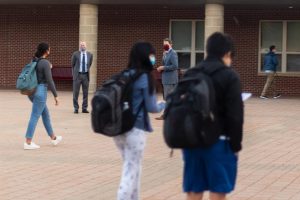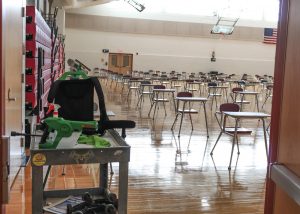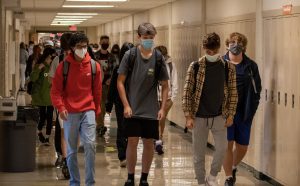Zoom creates connections during remote learning
Most teachers believe that while certain topics are better taught in person, Zoom meetings are important in simulating a classroom-style environment.
January 15, 2021
Since the start of hybrid learning, the effectiveness of Zoom meetings for teaching and learning has been put to the test and proven successful, though some students don’t believe online classes are effective.
According to a Harbinger survey of 236 students conducted through Google Forms from Dec. 7 to Dec. 12, 78 percent of the respondents prefer the asynchronous activities during fully remote days instead of Zoom classes. However, many faculty members believe there are benefits of being able to meet with the entire class at one time during the COVID-19 pandemic.
Zoom meetings are used often in the classroom and require a schedule to keep them organized. Principal Sean Bevan spent a lot of time creating a thoughtfully planned schedule that includes Zoom meetings.
“We had to develop a schedule that included a remote component to give us more space in the building so students could be spaced out,” Bevan said. “We built a remote model based on the necessity to be socially distant. Finally, we decided on the best way for instruction to be delivered, and Zoom was the best way for our students to learn remotely.”
After just past a term using the hybrid model schedule, Bevan made sure that every member of the school community’s voices were heard through a student survey and that there were opportunities for teacher feedback in hopes that educators would be able to teach in the best way possible.
“Zoom provides the ability to communicate and see students visually,” Bevan said. “A very important part of my job currently is listening to student data and hearing from teachers on what is working.”
While making sure that the hybrid learning model is working correctly, Bevan sees that tasks such as reading and writing will lend themselves to asynchronous learning but feels that Zoom meetings are still essential to maintain a classroom-style environment.
“The way that Zoom meetings are used can be very specific to each class,” Bevan said. “Many teachers will end up doing live lessons and instruction over Zoom, and some choose not to. Certain tasks will lend themselves really well to live classes such as a new lesson that requires both cohorts to be present.”
Since technology is such a large factor that goes into Zoom meetings and remote learning, Instructional Technology Coordinator Brian Calnan understands the most important parts of a virtual class.
“On the fully remote days, I think teachers use Zoom to come together as a class and unite both cohorts,” Calnan said.
Even though he believes Zoom meetings are great at many things, Calnan noted there are always going to be some minor technical issues.
“It can certainly be tricky for teachers to balance the in person learning and the fully remote learning on the hybrid days, but everyone is doing their best effort,” Calnan said. “There is a reason that schools are typically in person, and that has worked well for a long time.”
Calnan still thinks that Zoom meetings are effective overall and give the much needed interaction that students desire, but sees the social challenges that can be present when attending class virtually.
“I think that one of the biggest challenges for the teachers is forming the connection with students at the beginning of the year,” Calnan said. “Being fully remote at the start of the year and transitioning to the hybrid model, it has certainly been tough for teachers to consider how they were going to get to know their students and build a classroom environment.”
Zoom sessions can be helpful for many teachers, and for math teacher Eileen Cronin, the live classes show her who is attending, who is participating and better notice who is understanding the content.
“I think it’s important for the teacher and the student to see each other daily almost like it’s a normal week,” Cronin said. “I have a lot of freshmen, and I don’t know what a lot of my students really look and act like because they are behind a screen much of the time. I think daily live lessons allow the students to make a connection and get to know each other.”
While still able to make connections, Cronin has stopped doing group work activities within each class and has also altered the curriculum due to less learning time.
“Since the pandemic, the curriculum is being rolled out more slowly,” Cronin said. “I’m skipping certain sections from the textbook that I don’t think are critical for understanding.”
While adjusting to the change in teaching style, Cronin has seen some students putting in a lot of effort and hopes that her students will participate more in virtual classes. According to the Harbinger survey, 52 percent of respondents said that their productivity level is a six out of ten or higher, indicating a positive productivity level.
“I think motivated students who really want to learn do well and want to get through the pandemic successfully are making the most out of it,” Cronin said. “A lot of my day is spent trying to figure out if kids are actually sick or if they are just getting a little bit lazy.”
Cronin is disappointed that the freshman class this year isn’t able to have the traditional fall activities, but thinks that Zoom classes are able to make the best of the situation.
“I think that Zoom meetings are effective, but the student has to show up and engage,” Cronin says. “The students get out of Zoom meetings what they put in. I think that while the Zoom meeting is not the best situation, at least the kids are showing up.”
Fully remote learners, such as freshman River Doyle-Saxson, who don’t participate in in-person classes. Instead, Zoom meetings allow them to learn at home, although Doyle-Saxson finds it harder to connect with classmates virtually.
“I think Zoom is different, but I’ve found it to be pretty good for learning,” Doyle-Saxson said. It’s harder to connect with people, because it really isn’t the same as learning in person.”
Thanks to the use of breakout rooms, Doyle-Saxson is able to socialize one on one with classmates and participate in class although constant virtual learning can become tiring.
“It’s been a lot easier to participate over the screen,” Doyle-Saxson said. “I do occasionally get sick of being at my computer the whole time.”
With the different teaching styles that fully remote learning has required, Doyle-Saxson has found some topics, such as math, easier to learn on Zoom.
“I think that remote learning has been a lot different,” Doyle-Saxson said. “But in some ways I think certain topics have been easier to learn than they would be in person, such as math.”
Compared to fully remote learning, hybrid instruction presents a whole set of different challenges. Senior Julia Mazze has been able to find the positives and negatives of going to school in-person two days a week.
“I like coming in to school a lot better, but I find that I definitely have a lot more work after school,” Mazze said. “I get pretty tired after the long days at school, but it’s worth it because I like to be challenged.”
While going into school, Mazze sees the importance of being in a hybrid learning environment.
“I think that the remote days are certainly helpful,” Mazze said. “Although I think I have a better learning experience when I come into school.”
Not being in school all of the time presents the challenge of not having lessons every day, and Mazze knows how much it matters to make sure she studies.
“A lot of my teachers have sent their classes videos and activities that are much different than what we would watch prior to the COVID-19 pandemic,” Mazze said. “I’m making sure to better myself and study the content.”
Mazze sees the benefits of Zoom meetings, but also admits that they can be challenging.
“Overall, my Zoom meetings can definitely be hard,” Mazze said. “For the most part my teachers have been pretty helpful and understanding when it comes to any issues that we are experiencing.”













